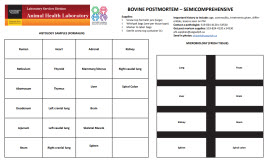The cause of death may not be determined despite a very thorough examination. A number of possible causes should, however, be eliminated. Postmortem examination and sample selection should take place as soon after death as possible.
IF IN DOUBT ABOUT HOW TO PROCEED, PLEASE CONSULT A PATHOLOGIST AT THE AHL.
A. Previously healthy, found dead
Circumstances may indicate possible samples to submit. Rule-outs include:
All species: anaphylaxis, adverse drug reaction, bleed-out, electrocution (lightning), physical trauma (moving vehicle, self-trauma), gunshot, drowning, intestinal accident, botulism, septicemia (leptospirosis, salmonellosis), heat stroke, poisonous plants (Japanese yew), other poisons.
Cattle - bloat, ruptured liver abscess, anthrax, blackleg, coliform mastitis, Histophilus somni (Haemophilus somnus), hypomagnesemia, lead poisoning, hypocalcemia, nutritional myopathy.
B. Suspected poisonings
Most such cases are not proven to be poisonings. Other causes of death should be ruled out before toxicology is undertaken. Known exposure to a toxicant would be useful; we can conduct a wide variety of assays, but have very few screening tests - a request to “check for toxins” is not adequate.
Please see the Toxicology [1] and Toxicology Sampling [2] section for more details.
C. Submitting samples
1. Give a complete history, including number affected and number at risk, and when the animal was last seen alive.
2. Submit either the entire carcass OR conduct a routine complete postmortem, record your findings in detail and submit:
- Formalinized samples for histology (brain, thyroid, thymus, lung, heart, liver, spleen, adrenal, kidney, pancreas, stomach, duodenum, jejunum, ileum, colon, urinary bladder, skeletal muscle); appropriate samples for bacteriology.
- In case of a suspected cardiac cause of death, submit the whole heart (dog, cat), OR after weighing the carcass and heart and dissecting the heart, weigh right ventricular free wall and left ventricle + septum, and submit sections of both atria, both ventricles, and septum. Remember that lung and liver are also very useful for histologic examination in cases of suspect cardiac failure.
- Freeze and hold tissues for possible toxicology [brain (for organophosphates and carbamates), liver, kidney, stomach content, fat, and, if available, serum, EDTA blood, urine].
3. Hold feed or water samples, if suspicious of either.
4. Submit sample of suspected toxicant and/or its container.
